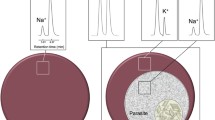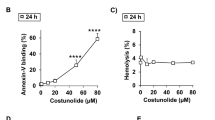Abstract
Low K (LK) sheep red blood cells (SRBCs) serve as a model to study K-Cl cotransport which plays an important role in cellular dehydration in human erythrocytes homozygous for hemoglobin S. Cinchona bark derivatives, such as quinine (Q) and quinidine (QD), are effectively used in the treatment of malaria. In the present study, we investigated in LK SRBCs, the effect of various concentrations of Q and QD on Cl-dependent K efflux and Rb influx (K(Rb)-Cl flux), activated by either swelling in hyposmotic media, thiol alkylation with N-ethylmaleimide (NEM), or by cellular Mg (Mg i ) removal through A23187 in the presence of external chelators. K efflux or Rb influx were determined in Cl and NO3 medium and K(Rb)-Cl flux was defined as the Cl-dependent (Cl minus NO3) component. K(Rb)-Cl flux stimulated by all three interventions was inhibited by both Q and QD in a dose-dependent manner. Maximum inhibition of K(Rb)-Cl flux occurred at Q and QD concentrations ⩾1 mm. The inhibitory effect of Q was manifested in Cl, but not in NO3, whereas QD reduced K and Rb fluxes both in Cl and NO3 media. The mean 50% inhibitory concentration (IC50) of Q and QD to inhibit K(Rb)-Cl flux varied between 0.23 and 2.24 mm. From determinations of the percentages of inhibition of the different components of K and Rb fluxes, we found that SRBCs possess a Cl-dependent QD-sensitive and a Cl-dependent QD-insensitive K efflux and Rb influx. These two components vary in magnitude depending on the manipulation and directional flux, but in average they are about 50% of the total Cl-dependent flux. This study raises the possibility that, in SRBCs, the Cl-dependent K(Rb) fluxes are heterogeneous.
This work was supported by a grant from the National Institutes of Health (NIH DK5RO1 37,160).
Similar content being viewed by others
References
Adragna, N.C., Lauf, P.K. 1994. Quinine and quinidine inhibit K-Cl cotransport in low K sheep erythrocytes. Biophys. J. 66:A32 (Abstr.)
Ahmad, S., Phillips, R.S., Stammer, C.H. 1992. Inhibition of pig kidney L-aromatic aminoacid decarboxylase by 2,3-methano-mtyrosines. J. Med. Chem. 35:1410–1417
Bookchin, R.M., Ortiz, O.E., Lew, V.L. 1991. Evidence for a direct reticulocyte origin of dense red cells in sickle cell anemia. J. Clin. Invest. 87:113–124
Brugnara, C., Van Ha, T., Tosteson, D.C. 1989. Role of chloride in potassium transport through a K-Cl cotransport system in human red cells. Am. J. Physiol. 256:C994-C1003
Covinsky, J.O., Conn, R.D. 1981. Quinidine. Therapeutic use and serum concentration monitoring. In: Individualizing Drug Therapy. Practical Applications of Drug Monitoring. W.J. Taylor and A.L. Finn, editors. pp. 111–132. Gross, Townsend, Frank, New York
Cowan, C.L., Cohen, R.A. 1992. Different mechanisms of relaxation of pig coronary artery to bradykinin and cromakalim are distinguished by potassium channel blockers. J. Pharmacol. Exp. Ther. 260:248–253
Cummings, T.A., Kinnamon, S.C. 1992. Apical K+ channels in Necturus taste cells. Modulation by intracellular factors and taste stimuli. J. Gen. Physiol. 99:591–613
Dahl, M.L., Nordin, C., Bertilsson, L. 1991. Enantioselective hydroxylation of nortriptyline in human liver microsomes, intestinal homogenate, and patients treated with nortriptyline. Ther. Drug Monit. 13:189–194
Deuticke, B., Grebe, R., Haest, C.W.M. 1990. Action of drugs on the erythrocyte membrane. Blood Cell. Bioch. 1:475–529
Discala, F., Belachgar, F., Planelies, G., Hulin, P., Anagnostopoulos, T. 1992. Barium-or quinine-induced depolarization activates K+, Na+ and cationic conductances in frog proximal tubular cells. J. Physiol. 448:525–537
Dunham, P.B. (1990). K,Cl cotransport in mammalian erythrocytes. In: Regulation of Potassium Transport across Biological Membranes. L. Reuss, J.M. Russel, and G. Szabo, editors, pp. 331–360. University of Texas Austin
el Benna, J., Pasquier, C., Labro, M.T. 1991. Quinine uptake by human polymorphonuclear neutrophils. Antimicrob. Agents Chemother. 35:1474–1478
Ellory, J.C., Dunham, P.B. 1980. Volume-dependent passive potassium transport in LK sheep red cells. In: Membrane Transport in Erythrocytes. Alfred Benzon Symposium 14. U. Lassen, H.H. Ussing, and J.O. Wieth, editors. pp. 409–425. Munskgaard, Copenhagen
Garay, R.P., Nazaret, C., Hannaert, P.S., and Cragoe, E.J., Jr. 1988. Demonstration of a [K+,Cl]-cotransport system in human red cells by its sensitivity to [(Dihydroindenyl)oxy]alkanoic acids: regulation of cell swelling and distinction from the bumetanide-sensitive [Na+,K+,Cl−]-cotransport system. Mol. Pharmacol. 33:696–701
Gendrel, D., Kombila, M., Nardou, M., Gendrel, C., Djouba, F., Martz, M., Richard-Lenoble, D. 1992. Malaria and Hemoglobin S: Interactions in African children. Presse Med. 21:887–890
Goldstein, J.L., Fogelson, B.G., Snow, J.C., Schmidt, L.N., Mozwecz, H., Layden, T.J. 1993. Rabbit esophageal cells possess K+ channels: effect of hyposmotic stress on channel activity. Gastroenterology 104:417–426
Halsberg, A., Romanin, C., Koerber, R. 1992. Membrane potential modulates release of tumor necrosis factor in lipopolysaccharidestimulated mouse macrophages. Mol. Biol. Cell 3:451–460
Hille, B. 1992. Ionic Channels of Excitable Membranes, pp. 291–314, 390–422. Sinauer Associates, Sunderland, MA
Hughes, I.E., Ilett, K.F., Jellett L.B. 1975. The distribution of quinidine in human blood. Br. J. Clin. Pharmacol. 2:521–525
Ikehara, T., Takahashi, A., Yamaguchi, H., Hosokawa, K., Masuya, T., Miyamoto, H. 1991. Regulatory changes in the K+, Cl− and water contents of HeLa cells incubated in an isosmotic high K(+)-medium. Biochim. Biophys. Acta 1068:87–96
Kaji, D. 1986. Volume-sensitive K transport in human erythrocytes. J. Gen. Physiol. 88:719–738
Kaji, D. 1992. Effect of varying membrane potential on K-Cl cotransport in human erythrocytes. Am. J. Physiol. 264:C376-C382
Karbwang, J., Molunto, P., Bunnag, D., Harinasuta, T. 1991. Plasma quinine levels in patients with falciparum malaria when given alone or in combination with tetracycline with or without primaquine. Southeast Asian J. Trop. Med. Public Health 22:72–76
Lauf, P.K. 1983. Thiol-dependent passive K/Cl transport in sheep red cells. I. Dependence on chloride and external K+(Rb+)ions. J. Membrane Biol. 73:237–246
Lauf, P.K., 1988. Volume and anion dependency of ouabainresistant K-Rb fluxes in sheep red blood cells. Am. J. Physiol. 255:C331-C339
Lauf, P.K., Bauer, J., Adragna, N.C., Fujise, H., Zade-Oppen, A.M., Ryu, K.H., Delpire, E. 1992. Erythrocyte K-Cl cotransport: properties and regulation. Am. J. Physiol. 263:C917-C932
Lauf, P.K., Erdmann, A., Adragna, N.C. 1994. Response of K-Cl cotransport to pH and cellular magnesium in volume-clamped low K sheep erythrocytes: three equilibrium states. Am. J. Physiol. 266: C95-C103
Luchi, R., Helwig, J., Jr., Conn, H., Jr. 1963. Quinidine toxicity and its therapy: An experimental study. Am. Heart J. 65:340–348
Murakami, M., Takada, K., Muranishi, S. 1992. Further mechanistic study on intestinal absorption enhanced by unsaturated fatty acids: Reversible effect by sulfhydryl modification. Biochem. Biophys. Acta 117:83–89
Muralidharan, G., Hawes, E.M., McKay, G., Korchinski, E.D., Midha, K.K. 1991. Quinidine but not quinine inhibits in man the oxidative metabolic routes of methoxyphenamine which involve debrisoquine 4-hydroxylase. Eur. J. Clin. Pharmacol. 41:471–474
Muralidharan, G., Hawes, E.M., McKay, G., Midha, K.K. 1991. Quinine is a more potent inhibitor than quinidine in rat of the oxidative metabolic routes of methoxyphenamine which involve debrisoquine 4-hydroxylase. Xenobiotica 21:1441–1450
Ott, R.J., Hui, A.C., Wong, F.M., Hsyu, P.H., Giacomini, K.M. 1991. Interactions of quinidine and quinine and (+)-and (−)-pindolol with the organic cation/proton antiporter in renal brushborder membrane vesicles. Biochem. Pharmacol. 41:142–145
Sabchareon, A., Chongsuphajaisiddhi, T., Attanath, P., Singhasivanon, V., Acmor-Apolinar, M.M., Pojjaroen-Anant, C. 1991. Red cell plasma concentrations of combined quinine-quinidine and quinine in falciparum malaria. Ann. Trop. Paediatr. 11:315–324
Schlatter, E., Bleich, M., Hirsch, J., Markstahler, U., Frobe, U., Greger, R. 1993. Cation specificity and pharmacological properties of the Ca(2+)-dependent K+ channel of rat cortical collecting ducts. Pfluegers Arch. 422:481–491
Slater, A.F.G., Ceramil, A. 1992. Inhibition by chloroquine of a novel haem polymerase enzyme activity in malaria trophozoites. Nature 355:167–169
Sugioka, Y., Suzuki, M. 1991. The chemical basis for the ferriprotoporphyrin IX-chloroquine complex induced lipid peroxidation. Biochim. Biophys. Acta 1074:19–24
Takeuchi, S., Marcus, D.C., Wangemann, P. 1992. Maxi K+ channel in apical membrane of vestibular dark cells. Am. J. Physiol. 262:C1430–1436
Wang, H., Grahame-Smith, D.G. 1992. The effects of rubidium, caesium and quinine on 5-HT-mediated behaviour in rat and mouse. 3. Quinine. Neuropharmacology 31:425–431
Warrell, D.A. 1992. Cerebral Malaria. Schweiz Med. Wochenschr. 122:879–886
Watt, G., Shanks, G.D., Edstein, M.D., Pavanand, K., Webster, H.K., Wechgritaya, S. 1991. Ciprofloxacin treatment of drugresistant falciparum malaria. J. Infect. Dis. 164:602–604
Xiao, J., Nie, L.H., Yao, S.Z. 1991. Transfer mechanism of quinine drug across the oil/water (O/W) interface. Sci. China B 34:42–53
Author information
Authors and Affiliations
Additional information
We thank Dr. Luo Lu from the Department of Physiology and Biophysics for helpful discussions, Mrs. Samyuktha Ramalingam for excellent technical assistance, undergraduate summer student, Salman Elmi, for assisting in the calculations, and the Word Processing Center of Wright State University School of Medicine for typing of this manuscript.
Rights and permissions
About this article
Cite this article
Adragna, N.C., Lauf, P.K. Quinine and quinidine inhibit and reveal heterogeneity of K-Cl cotransport in low K sheep erythrocytes. J. Membarin Biol. 142, 195–207 (1994). https://doi.org/10.1007/BF00234941
Received:
Revised:
Issue Date:
DOI: https://doi.org/10.1007/BF00234941




